An excerpt from my new book: .NET Core in Action
Learning a new development framework is a big investment. You need to learn how to write, build, test, deploy, and maintain applications in the new framework. For developers, there are many frameworks to choose from, and it’s difficult to know which is the best for the job. What makes .NET Core worth the investment?
To answer this question, it helps to know where you’re starting from. If you’re completely new to .NET, welcome! If you’re already a .NET developer, I’ll provide some guidance as to whether .NET Core is right for you at this time. .NET Core is still evolving to meet customer demands, so if there is a critical piece of the .NET Framework you need, it may be good to wait a few releases. Whether you are familiar with .NET or are just learning about it, .NET Core in Action will get you writing professional applications with .NET Core in short time.
Architecting enterprise applications before .NET Core
Early in my career, I worked for a car insurance company. Its developers were attempting to improve the efficiency of claims adjusters. When you get into a car accident, a representative of the insurance company—a claims adjuster—will sometimes go directly to the scene of the accident and assess the damage. Adjustors would collect information, usually on paper, and then head back to the office where they could enter the data into an application on a desktop or laptop computer. The process was slow and required a lot of manual work.
The insurance company wanted to enable claims adjusters to enter the data directly into the claims system from the scene. They would then be able to get cost estimates and access the car owner’s insurance policy on the spot. For the insurance company, this meant quicker claim resolution and less cost. One of the secrets I learned about the car insurance industry is that they want to get a disbursement to the claimant quickly. The less time the claimant has to reflect on the estimate, the less likely they’ll negotiate for a higher payout.
Accessing the claims system from the scene meant changing the architecture to incorporate mobile devices. The below figure shows the high-level design.
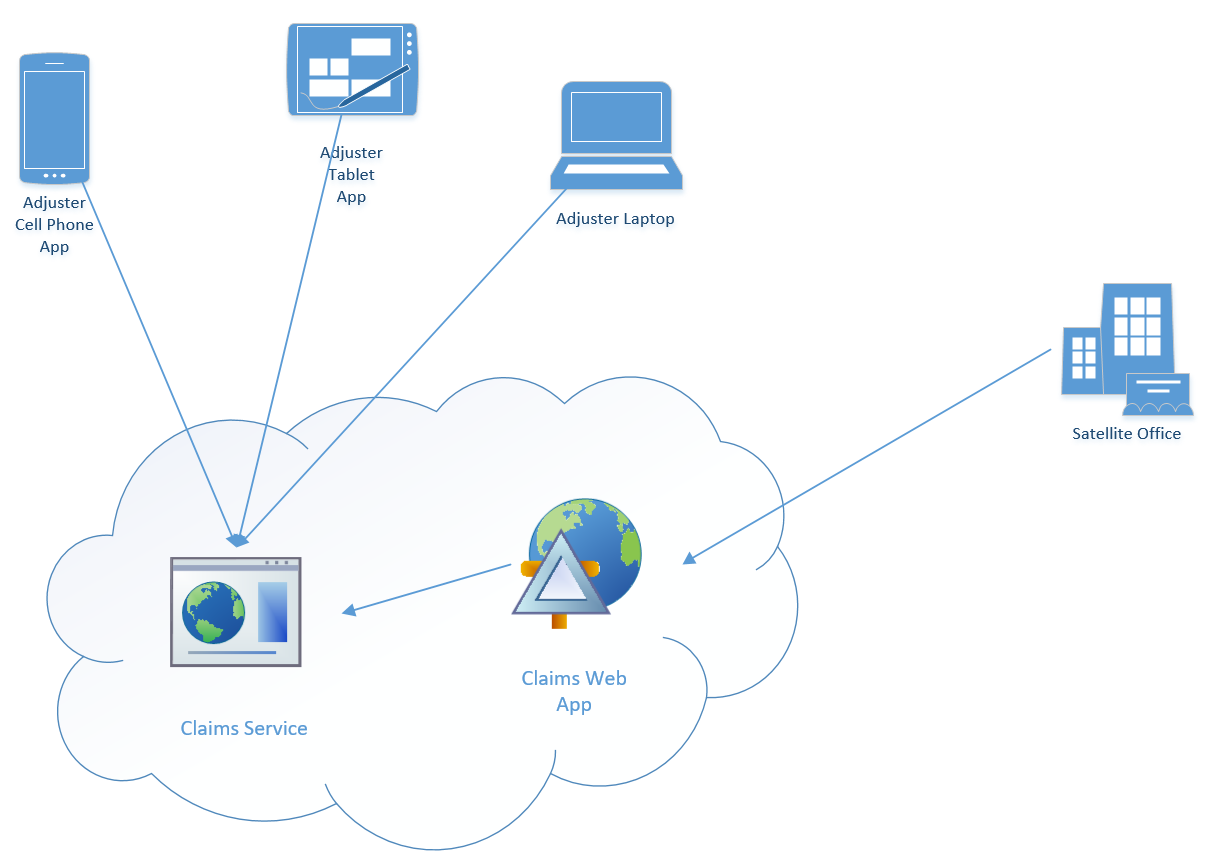
In the past, implementing this kind of architecture equated to substantial costs. Creating cell phone and tablet applications required either hiring developers for both iOS and Android ports or standardizing on hardware to limit the number of platforms. An adjuster might travel to a remote location with poor or nonexistent cellular service, so the application needed to operate offline. The different languages and platforms used in each piece of the architecture made integration and maintenance difficult. Changes in business logic meant rewriting the logic in several languages. At the time, scaling was too slow to adjust for demand during the workday, so the hardware requirements were based on peak load. The expenses kept piling up.
What if you could use not just the same code but the same libraries across the applications, website, and services? What if you built one app and it worked on iOS, Android, and Windows? What if your website and services could fit into small containers and elastically scale in response to demand? If all that were possible, it would dramatically reduce the cost of building and maintaining systems like the claims architecture.
These questions are no longer hypothetical. .NET Core is a software framework that makes all of this possible. Developers are not confined to a particular language, operating system, or form factor. .NET Core is engineered to be small and modular, making it perfect for containers. It is built and supported by Microsoft but is also open source, with an active community. Having participated in software projects like the claims application, I’m excited about the possibilities introduced by .NET Core.
If you are a .NET Framework developer
For some .NET Framework components, .NET Core is a reboot, and for others it’s a chance to work cross-platform. Because the .NET Framework was built mostly in managed (C#) code, those portions didn’t need code changes to move to .NET Core. But there are libraries that depend on Windows-specific components, and they had to either be removed or refactored to use cross-platform alternatives. The same will apply to your applications.
Your .NET apps can be cross-platform
Once they’re ported to .NET Core, your existing .NET Framework applications can now work on other operating systems. This is great for library authors who want to expand their audience or developers who want to use the same code in different parts of a distributed application. It’s also great if you’d just like to develop in .NET on your shiny new MacBook without having to dual boot to Windows.
Although not all of the Framework has been ported to .NET Core, major portions have. There are also some API differences. For example, if you use a lot of reflection, you may need to refactor your code to work with .NET Core. Section «DifferencesFromNetFramework» provides more information on the differences, which can help you determine if it’s feasible to port to .NET Core.
ASP.NET Core outperforms ASP.NET in the .NET Framework
The ASP.NET team built a new version of ASP.NET for .NET Core called ASP.NET Core. The difference in performance between ASP.NET Core and Framework ASP.NET is many orders of magnitude. Much of ASP.NET was built on the legacy System.Web library, and the .NET Framework supports older versions of ASP.NET projects. That constraint has restricted ASP.NET’s evolution. With .NET Core, Microsoft decided to rewrite the whole stack. Although this does mean breaking changes, the gains are worth the effort of migrating.
.NET Core is the focus for innovation
One of the critical principles of the .NET Framework is that new releases shouldn’t break existing applications. But this backwards compatibility is a double-edged sword. A lot of effort goes into making sure that changes made in new releases of the .NET Framework usually won’t break existing applications. But this goal of avoiding breaking changes restricts innovation. Changes to the .NET Framework need thorough justification (usually from customers), exhaustive testing, and approval from many levels of product groups. I’ve been in meetings where people argued over one- or two-line code fixes, which caused me to reconsider my life choices.
With .NET Core, it’s much easier for internal Microsoft teams to work on their library independent of the core libraries. Changes to core libraries, like System.Collections, still require the same rigor as with .NET Framework, but it’s easier to make substantial changes to ASP.NET Core or Entity Framework Core without being constrained by backwards compatibility. This allows for greater innovation.
.NET Framework ships as one product, whereas Core is broken up into pieces. Developers can now choose which version of a library they want to use, as long as it’s outside the .NET Standard Library, and .NET Core teams can innovate with less difficulty. This is why, in the future, you’ll see only bug fixes for the Framework. Core will get all the new features.
Release cycles are faster
If you’ve ever encountered a bug in the .NET Framework and reported it to Microsoft, you’re aware of how long it takes for a fix to be released. The Framework has long release cycles, usually measuring at least a year, and there are tiny windows during these cycles for feature work. Each code change can cause issues in unexpected places elsewhere in the Framework. To give each team enough time to test, there are many times when code changes are restricted or heavily scrutinized. If you find a bug in .NET, you’re better off finding a workaround than waiting for an update.
.NET Core follows a faster release cadence. Developers can use nightly builds to test early. Libraries that aren’t part of the .NET Standard Library can release at their own pace. Because everything is open source, any developer can propose a fix if Microsoft doesn’t respond quickly enough. If the fix isn’t accepted, the discussion is held in public so everyone can see why that decision was made.
If you are new to .NET
On Windows platforms, the .NET Framework hasn’t had much competition. Microsoft could make changes to everything from the OS kernel layers up through the high-level .NET libraries. By taking .NET to other platforms, the playing field has changed. .NET must now compete with all the other development frameworks out there. Here are some things that set .NET apart.
C# is an amazing language
The flagship language of .NET, C#, has many distinguishing features, such as Language Integrated Query (LINQ) and asynchronous constructs, which make it powerful and easy to use. C# also continues to innovate. The C# team designs the language openly so that anyone can make suggestions or participate in the discussion. The compiler (Roslyn) is entirely modular and extensible. I recommend picking up another Manning book, C# in Depth by Jon Skeet, to learn more.
.NET Core is not starting from scratch
.NET has been around since before 2000. The Framework code has been hardened over the years, and its developers have benefited from the experience. Much of the Framework code that has been ported to Core is untouched. This gives .NET Core a head start in terms of having a reliable framework for building applications. .NET Core is also completely supported by Microsoft. A lack of support can keep some organizations from adopting open source software. Microsoft’s support decreases the risk of using Core for your applications.
Focus on performance
The Common Language Runtime (CLR) team at Microsoft has been optimizing garbage collection and just-in-time (JIT) compilation since the beginning of .NET, and they’re bringing this highly tuned engine to .NET Core. They also have projects underway to perform native compilation of .NET Core applications, which will significantly reduce startup times and the size on disk—two important characteristics for fast scaling in container environments.
What is .NET Core?
To understand .NET Core, it helps to understand the .NET Framework. Microsoft released the .NET Framework in the early 2000s. The .NET Framework is a Windows-only development framework that, at its lowest level, provides memory management, security, exception handling, and many other features. It comes with an extensive set of libraries that perform all kinds of functions, from XML parsing to HTTP requests. It also supports several languages and compiles them into the same common intermediate language, so any language can use a library built in any other language. These key concepts are also present in .NET Core.
In 2016, Microsoft acquired Xamarin and released .NET Core 1.0. Xamarin was responsible for porting large parts of the .NET Framework to run on Linux/Unix-based operating systems in the past. Although some of the code could be shared between the .NET Framework, Xamarin, and the new .NET Core, the compiled binaries could not. Part of the effort of building .NET Core was to standardize so that all .NET implementations could share the same libraries. The figure below shows what this standardization looks like.
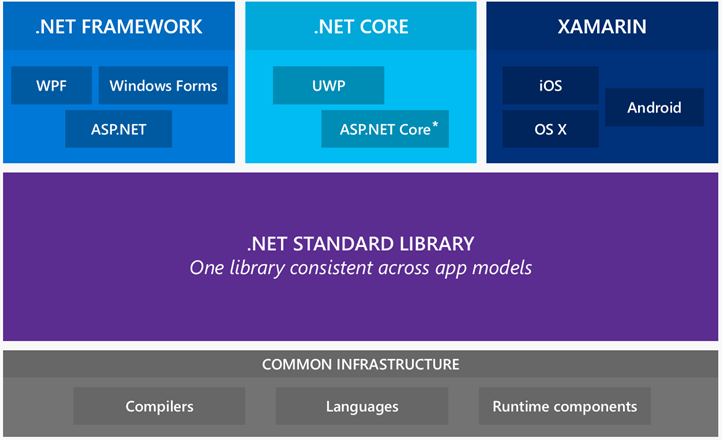
Xamarin and the .NET Framework were previously silos, where binaries could not be shared between them. With the introduction of the .NET Standard Library and the common infrastructure, these two frameworks are now part of a unified .NET ecosystem.
So what is .NET Core then? In figure «DotnetCoreArchitecture» it appears that .NET Core is just another framework that includes UWP (Universal Windows Platform) and ASP.NET Core. In order to make .NET Core a reality, however, the authors also created the .NET Standard Library and the common infrastructure. .NET Core is really all three of these things.
Key .NET Core features
.NET Core borrows the best from the .NET Framework and incorporates the latest advancements in software engineering. The following sections identify a few of the distinguishing features of .NET Core.
Expanding the reach of your libraries
With .NET Core you can write your application or library using the .NET Standard Library.
Then it can be shared across many platforms. In the figure below, MyLibrary is
deployed across cloud services, web servers, and many client platforms.
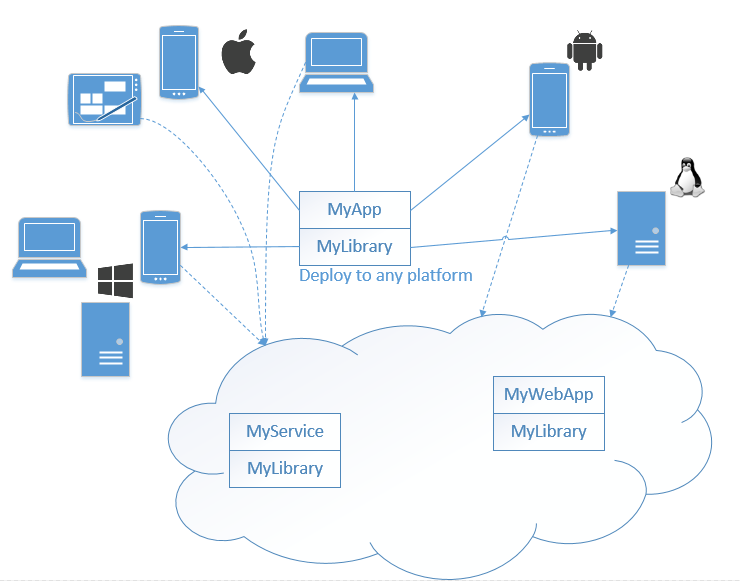
The same library can work in your backend service on your premises or in the cloud and also in your client application running on a cell phone, tablet, or desktop. Instead of building separate apps for iOS, Android, and Windows, you can build one app that works on all platforms. .NET Core is small and perfect for use in containers, which scale easily and reduce development time.
.NET Core and the .NET Standard Library establish a common standard. In the past when a new version of an operating system or a new device came along, it was the responsibility of the developer to rebuild their application or library for that new runtime or framework and distribute the update. With .NET Core there is no need to rebuild and redistribute. As long as the new runtime or framework supports all of your dependent libraries, it will support your application.
Simple deployment on any platform
Microsoft products tend to have complex installation processes. COM components, registry entries, special folders, GAC—all are designed to take advantage of Windows-only features. The .NET Framework relies on these constructs, which makes it unsuitable for other operating systems.
When shipping an application that relies on the .NET Framework, the installer has to be smart enough to detect whether the right .NET Framework version is installed, and if not, provide a way for the user to get it. Most modern Windows versions include the .NET Framework, and this makes certain applications easier to install, but it can cause complications if the application uses features that are not installed by default, such as ASP.NET integration with IIS or WCF components.
Another complication comes from patches. Patches that include bug fixes or security updates can be distributed to customers via Windows update or through the Microsoft Download Center. But the .NET Framework you test your application on may have different patches than the ones customers are using. It is often difficult to determine what causes strange behavior in an application if you assume that the .NET Framework is the same for all customers.
.NET Core’s modular design means that you only include the dependencies you need, and all of those dependencies go into the same folder as your application. Deploying an application is now as simple as copying a folder—what Microsofties refer to as “xcopy-deployable” (xcopy being a Windows tool for copying files and folders). Another advantage to this approach is that you can have multiple versions running side by side. This strategy is key to making the deployment experience consistent on all platforms.
Clouds and containers
In cloud systems, it’s important to drive for higher density—serving more customers with less hardware. The smaller the footprint of an application, the higher the density.
The most common approach to deploying an application in cloud systems has been the virtual machine. A virtual machine allows an operating system to be installed on virtual hardware. The virtual machine is stored in a small number of files that can be easily replicated. But virtual machines have several problems:
- Size — A typical virtual machine file is gigabytes, if not tens of gigabytes. This makes it time-consuming to transfer them across networks, and it has significant requirements on disk space.
- Startup times — Starting a virtual machine means starting an operating system. For Windows, this presents a challenge, because it may take minutes to start a new machine. This can make handling sudden bursts of traffic difficult.
- Memory — The virtual machine needs to load an entire operating system into memory, along with the applications. This means a lot of a host’s memory can be redundant and therefore wasted.
- Inconsistency — Although the same virtual machine can be copied to multiple hosts, the hosts have to provide the same virtualized hardware, which can be dependent on the physical hardware. There is no guarantee that a virtual machine will operate the same way, if at all, on any given host.
Containers solve the issues of virtual machines by also virtualizing the operating system— the container only holds the application and its dependencies. File sizes are many times smaller, startup times are measured in seconds, only the application is loaded in memory, and the container is guaranteed to work the same on any host.
The .NET Framework was designed to be built into Windows, and it doesn’t fit well into containers. A Framework application depends on the Framework being installed. Given the clear advantages of containers, one of the design decisions of .NET Core was to make it modular. This means that your .NET Core application can be “published” so that it and all of its dependencies are in one place, which makes it easy to put into a container.
ASP.NET performance
ASP.NET is a set of libraries built into the .NET Framework for creating web applications. It was released in 2002 with the first version of the .NET Framework, and it has continued to evolve. Despite its success (being used by many high-profile organizations, including Stack Overflow), there was a feeling among the ASP.NET team that they were losing developers because ASP.NET performance is not competitive, and because it only works on the Windows platform.
A company called TechEmpower runs a benchmark of web application frameworks every few months and provides a ranking in several categories. The benchmarks are run on Linux, so Windows-only frameworks are not included. For the ASP.NET team, this was a problem. There are many frameworks for writing cross-platform web applications, and their performance numbers are impressive. Some Java frameworks, like Rapidoid and Undertow, were posting astronomical numbers: Rapidoid with 3.7 million plaintext requests per second and Undertow with 2.9 million.
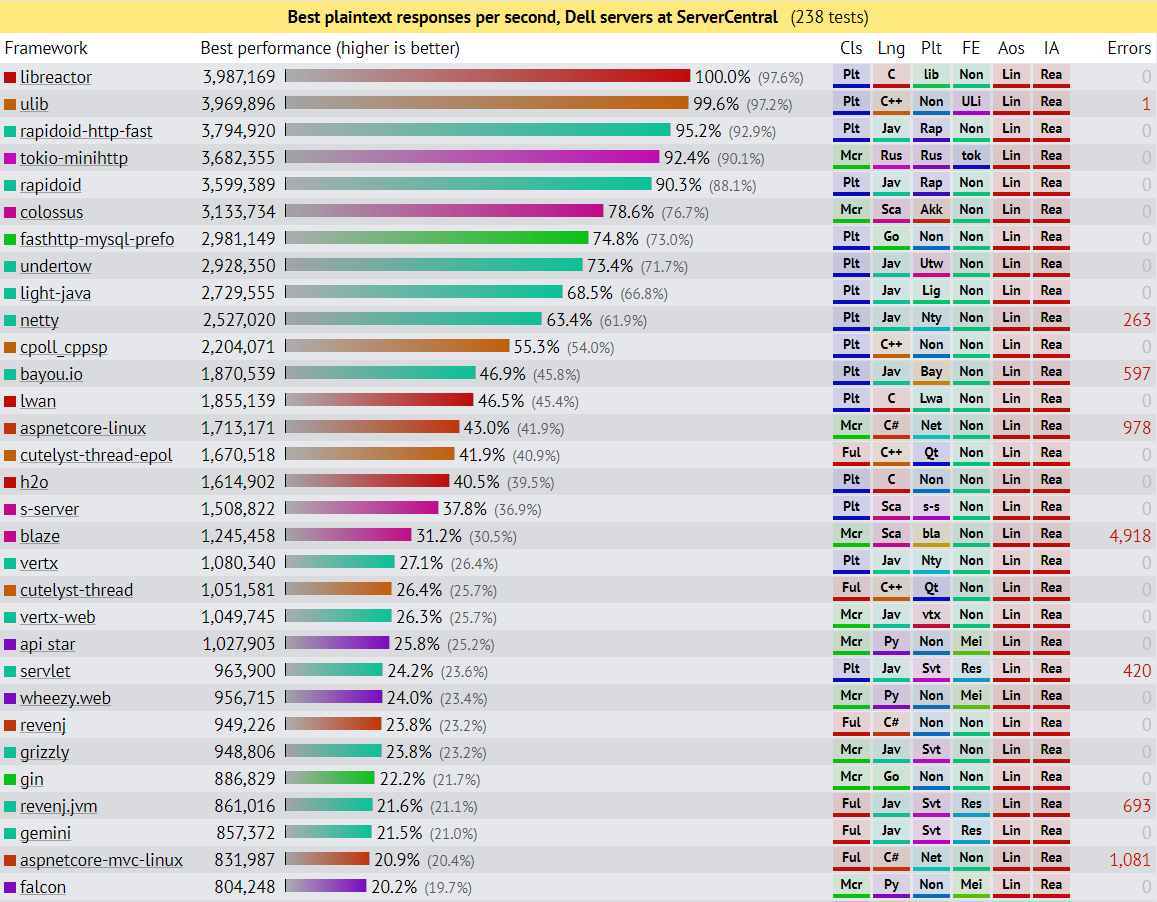
On round 11 of the TechEmpower benchmark, ASP.NET MVC on the Mono framework was included in the testing. The results were not good. ASP.NET on Mono produced a paltry 2,000 plaintext requests per second. But because Mono wasn’t created by Microsoft, it wouldn’t have received the same amount of performance tuning as the regular .NET Framework. To get a fairer comparison, the ASP.NET team decided to run a benchmark with .NET 4.6 on the same hardware as TechEmpower. The result was around 50,000 requests per second, not even close to NodeJS (320,000 requests per second) or any of the other top frameworks on the TechEmpower list.
The pitifully low score wasn’t exactly a surprise. As mentioned before, the ASP.NET team knew some of the hurdles that stood in the way of being competitive with frameworks like NodeJS. These hurdles could only be cleared by rewriting the whole thing. One major difficulty with ASP.NET was that it needed to support customers’ legacy code, including “classic ASP,” which preceded .NET. The only way to free ASP.NET from the legacy code burden was to start over.
The ASP.NET team embarked on building ASP.NET Core, and many months later they celebrated crossing the 1 million requests per second mark. There is a team dedicated to pushing that number even higher, as well as to improving the performance of many other real-world scenarios.
Improving the performance of ASP.NET is indicative of a shift in Microsoft’s thinking. Microsoft realizes that it has to be competitive to win developers. It also has to compete on platforms other than Windows. ASP.NET was the driving force behind the creation of .NET Core.
Open source
Historically, Microsoft has been very tight-lipped about new products and features under development. There are good reasons for this: First, the competition has less time to respond if they first find out about a feature on the day it ships. Also, if a feature was targeted for a particular release date and wasn’t done on time, it could be postponed without much issue, because customers didn’t know about it. Plus, it always helps to have new stuff to announce at conferences.
But modern software developers are not content to ask for a feature and hope it is delivered in the next release, which could be a year away. This is especially true when there may be an open source project that could fulfill their needs. As large companies warm to open source software, even the most faithful Microsoft developers turn to other frameworks and libraries to get their own projects done on time and within budget. Microsoft needed to make a change.
Exposing the source for the .NET Framework was the first step. The .NET Framework source code has been publicly available for years at referencesource.microsoft.com and also on GitHub. The Reference Source website makes it easy to search the source code of the .NET Framework.
It is one thing to expose the source and quite a different thing to accept external contributions. The .NET Core developers not only wanted to allow external contributions, they wanted to include the community in the design and development. This led to a lot more transparency. Every week, the ASP.NET Core team holds a live community standup meeting at http://live.asp.net. The code for .NET Core has been available publicly on GitHub from the start, and anyone can make a pull request. Community members can also create bugs and feature requests in GitHub. .NET Core marked a significant change in direction for Microsoft regarding open source.
Bring your own tools
Because .NET Core works on many platforms, command-line functionality is crucial for .NET Core tooling. For some Linux variants, or when working with Docker containers, a terminal may be all that’s available. The .NET Command-Line Interface (CLI) was designed for this purpose.
I can’t make any assumptions about what kind of editor you’ll use to write your code. You can use an integrated development environment like Visual Studio or a simple text editor like vi or emacs. There are also plenty of tools that feature syntax highlighting, like Notepad2 or Sublime.
Applying .NET Core to real-world applications
What sets .NET Core apart from other frameworks when it comes to building real-world applications? Let’s look back at the claims architecture diagram from earlier. A claims adjuster goes to the scene of an accident and enters the evidence (notes and photos, for example) into a software application that generates the estimate. In order to determine what evidence needs to be collected, the software may use complex, proprietary business logic. The adjuster needs to gather this information regardless of connectivity, so it will be helpful to have the business logic available in the mobile application.
Rewriting all the business logic in a language suitable for a mobile application introduces a maintenance issue. Both the team working on the server side and the team writing the mobile application must update their codebases with any changes to the business logic. Ownership gets split between teams, and keeping in sync becomes difficult. With Xamarin support for the .NET Standard library, web services and mobile applications alike can use the same business logic library. Claims adjusters get consistent behavior, and maintenance costs go down.
Scaling in response to demand
In the case of a natural disaster, such as a hurricane or flood, claims adjusters will be working overtime, increasing demand. The claims architecture needs to scale to meet this demand. With the improved performance of ASP.NET Core and the ability to deploy .NET Core applications to containers, adjusters can rely on the claims system to handle the workload. This is important to the insurance company, because downtime of backend systems directly affects customer experience and slows down adjusters.
Differences from the .NET Framework
.NET Core is not simply the .NET Framework for Linux and Mac. Rather than port all of the .NET Framework, Microsoft has taken the approach of waiting to see what customers want. There has to be enough customer interest in a framework feature to persuade Microsoft to allocate the resources to do a port. One of the obstacles to porting is that the teams that originally built these features have almost completely moved on. Luckily for ASP.NET customers, the ASP.NET team was the driver behind .NET Core. MVC, Web API, and SignalR are either all available in .NET Core or are on the roadmap.
Framework features not ported to Core
The following list identifies Framework features not currently ported to .NET Core, but I provide this with the knowledge that things can change. Some features don’t apply to non-Windows platforms. There are other features that Microsoft doesn’t want to carry forward into the future, either because there are better replacements or because the feature was problematic in some way (insecure, hard to maintain, etc.).
- WPF/XAML — The Windows Presentation Foundation is only meant for user interfaces. The .NET Standard Library does not include UI libraries, and .NET Core does not attempt to provide a cross-platform UI framework.
- Transactions — This library made it easy to create distributed transactions, but it relies on Windows-specific components, so it’s not readily portable to .NET Core.
- AppDomains — These were useful for isolating assemblies so they could be unloaded without killing the process, which is great for applications that allow plugins. They rely on some Windows-specific constructs that would not work on other operating systems.
- .NET remoting — Remote objects have been succeeded by REST services.
- ASMX — This was an old way of writing web services that has been replaced by Web API.
- Linq to SQL — This has been replaced by Entity Framework.
- WCF services — Windows Communication Foundation client capabilities are available in .NET Core, but you can’t create services.
- WF — Windows Workflow Foundation depends on XAML, WCF services, and transactions, among other .NET Framework-only features.
Subtle changes for .NET Framework developers
Experienced .NET Framework developers may encounter a few surprises when working in .NET
Core. Writing new code should be relatively straightforward, because you’re unlikely to use
older constructs like HashTable or ArrayList. Visual Studio’s Intellisense will also
indicate whether a type, method, property, and so on, is supported in .NET Core. In
the figure below, you can see the auto-completion window flagging members that are
different in .NET Core.
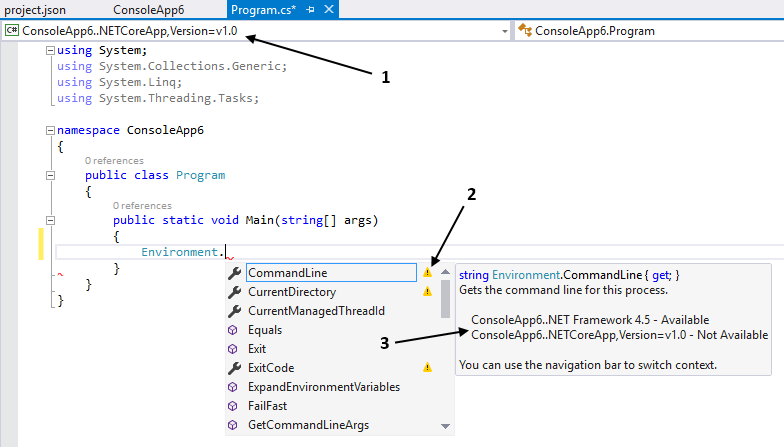
- Target Framework
- Member not available in some frameworks
- Lists availability of member by framework
.NET Portability Analyzer
If you’re attempting to convert an existing .NET application to .NET Core, the best place to start would be the .NET Portability Analyzer. It’s available both as a command-line application and a Visual Studio plugin. This tool creates a detailed report with useful suggestions wherever possible.
Changes to .NET reflection
Reflection works differently in .NET Core than in the .NET Framework. The most noticeable
difference is that a lot of the operations normally available in the Type class are no
longer available. Some have been moved to a new class called TypeInfo.
Additional resources
To find out more about .NET Core and C#, try the following resources:
- Microsoft’s .NET Core Guide: https://docs.microsoft.com/en-us/dotnet/core/
- C# in Depth, fourth edition, by Jon Skeet (Manning, 2018): http://mng.bz/6yPQ
- ASP.NET Core Community Standups: http://live.asp.net
Summary
The software development industry is constantly evolving. Everything is challenged and improved, from languages to frameworks to tools to methodologies. The .NET Framework has reached a point where it is too rigid and monolithic to keep up with its competitors. .NET Core is the necessary next step in the evolution of .NET. It combines the best of the .NET Framework with the practices used in modern software development.
Learning a new software development framework requires an investment of time and resources. Even if you’re familiar with the .NET Framework, there is much to learn about .NET Core. With .NET Core you can write code that’s portable across all platforms, use containers to control scaling, and build high-performance web applications.